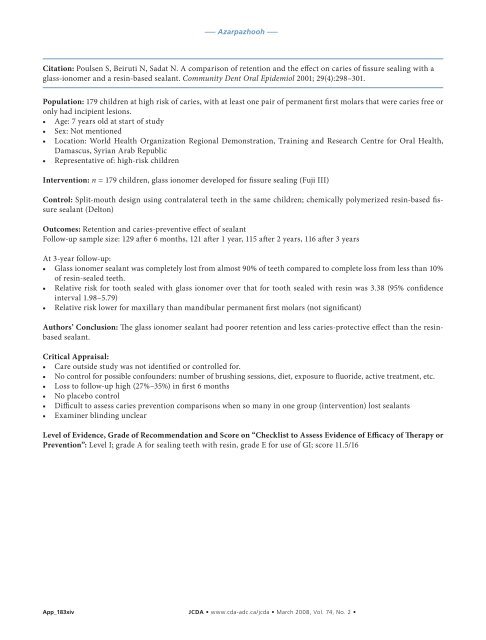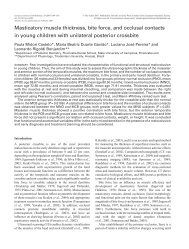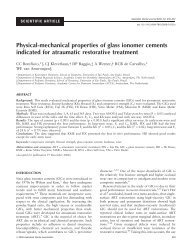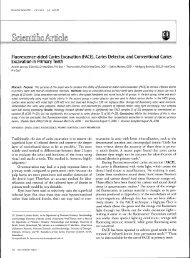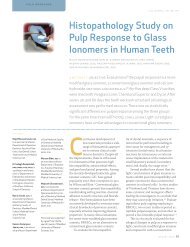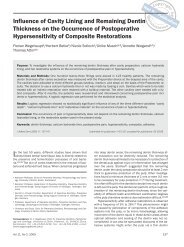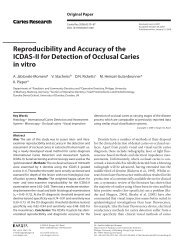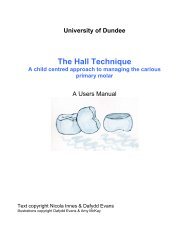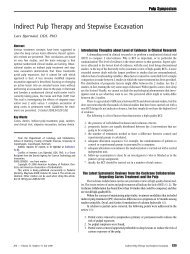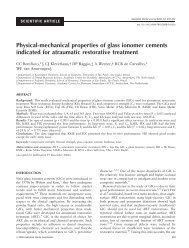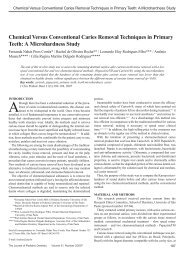Pit and Fissure Sealants in the Prevention of Dental Caries in ...
Pit and Fissure Sealants in the Prevention of Dental Caries in ...
Pit and Fissure Sealants in the Prevention of Dental Caries in ...
Create successful ePaper yourself
Turn your PDF publications into a flip-book with our unique Google optimized e-Paper software.
––– Azarpazhooh –––<br />
Citation: Poulsen S, Beiruti N, Sadat N. A comparison <strong>of</strong> retention <strong>and</strong> <strong>the</strong> effect on caries <strong>of</strong> fissure seal<strong>in</strong>g with a<br />
glass-ionomer <strong>and</strong> a res<strong>in</strong>-based sealant. Community Dent Oral Epidemiol 2001; 29(4):298–301.<br />
Population: 179 children at high risk <strong>of</strong> caries, with at least one pair <strong>of</strong> permanent first molars that were caries free or<br />
only had <strong>in</strong>cipient lesions.<br />
• Age: 7 years old at start <strong>of</strong> study<br />
• Sex: Not mentioned<br />
• Location: World Health Organization Regional Demonstration, Tra<strong>in</strong><strong>in</strong>g <strong>and</strong> Research Centre for Oral Health,<br />
Damascus, Syrian Arab Republic<br />
• Representative <strong>of</strong>: high-risk children<br />
Intervention: n = 179 children, glass ionomer developed for fissure seal<strong>in</strong>g (Fuji III)<br />
Control: Split-mouth design us<strong>in</strong>g contralateral teeth <strong>in</strong> <strong>the</strong> same children; chemically polymerized res<strong>in</strong>-based fissure<br />
sealant (Delton)<br />
Outcomes: Retention <strong>and</strong> caries-preventive effect <strong>of</strong> sealant<br />
Follow-up sample size: 129 after 6 months, 121 after 1 year, 115 after 2 years, 116 after 3 years<br />
At 3-year follow-up:<br />
• Glass ionomer sealant was completely lost from almost 90% <strong>of</strong> teeth compared to complete loss from less than 10%<br />
<strong>of</strong> res<strong>in</strong>-sealed teeth.<br />
• Relative risk for tooth sealed with glass ionomer over that for tooth sealed with res<strong>in</strong> was 3.38 (95% confidence<br />
<strong>in</strong>terval 1.98–5.79)<br />
• Relative risk lower for maxillary than m<strong>and</strong>ibular permanent first molars (not significant)<br />
Authors’ Conclusion: The glass ionomer sealant had poorer retention <strong>and</strong> less caries-protective effect than <strong>the</strong> res<strong>in</strong>based<br />
sealant.<br />
Critical Appraisal:<br />
• Care outside study was not identified or controlled for.<br />
• No control for possible confounders: number <strong>of</strong> brush<strong>in</strong>g sessions, diet, exposure to fluoride, active treatment, etc.<br />
• Loss to follow-up high (27%–35%) <strong>in</strong> first 6 months<br />
• No placebo control<br />
• Difficult to assess caries prevention comparisons when so many <strong>in</strong> one group (<strong>in</strong>tervention) lost sealants<br />
• Exam<strong>in</strong>er bl<strong>in</strong>d<strong>in</strong>g unclear<br />
Level <strong>of</strong> Evidence, Grade <strong>of</strong> Recommendation <strong>and</strong> Score on “Checklist to Assess Evidence <strong>of</strong> Efficacy <strong>of</strong> Therapy or<br />
<strong>Prevention</strong>”: Level I; grade A for seal<strong>in</strong>g teeth with res<strong>in</strong>, grade E for use <strong>of</strong> GI; score 11.5/16<br />
App_183xiv<br />
JCDA • www.cda-adc.ca/jcda • March 2008, Vol. 74, No. 2 •


